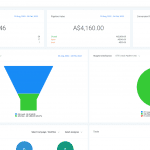It’s no secret that blogging for your business can yield amazing results. But, before you dive in and start writing your first article, it’s important to remember that a successful blog doesn’t happen by accident.
If you want your blog to be a hit, there are some important things to keep in mind, and some key elements of your blogging strategy that you need to get right. So, to help you get your blog up and running and on the right path, we’ve put together 6 steps for business blogging success.
Step 1: Share Content that Solves Real Problems
People don’t visit business blogs because they’re looking for some light reading—they’re actively seeking answers and solutions to their problems. Your blog provides you with the ideal platform to reach those potential customers who are online asking questions and give them the answers they need.
Do some digging, and find out what they want to know, then use your blog content to respond. Check out what your competitors are publishing, to be sure you’re offering a point of difference to the rest of the pack. Not only is a relevant and interesting blog a fantastic way to attract organic traffic to your website, you’ll also position your business as an industry leader who is genuinely keen to help.
Step 2: Be Sure to Include a Call to Action
It’s common to see company blogs that have no ‘next step’ offer (known as a CTA – or call to action) at the end of their blog post. This is a wasted opportunity! When you’ve gone to the effort to create a blog to attract potential customers, but have no next steps to direct them to take action, you run the risk of visitors leaving your site and forgetting all about you.
Instead, offer them the chance to download a more in-depth piece of content that dives deeper into the subject they are interested in, at the time they are interested. It’s likely they’ll be glad to sign up for your mailing list in exchange for some more valuable, free information that will help inform their buying decision. The format your gated content takes can be anything from a simple price list, to a 50-page ebook, whatever suits your target audience best. It’s mutually beneficial, as they gain more relevant information to help them solve their problem, and you’re now able to reach out to them with emails that keep you front of mind (see Step 3).
Step 3: Engage Your Contacts and Track Success
Creating a list of contacts via your CTA and gated content is one thing, but the list holds no value unless you do something with it. Engaging your contacts regularly via an email update is a great way to continue to add value and stay front of mind. Share handy tips and other useful information on a regular (but not too frequent basis) and you’ll put yourself well and truly in the frame when your contacts are ready to buy.
To do this effectively, you’ll need a platform to manage your mailing list, such as HubSpot or Mailchimp. These and other similar tools allow you to set up automations to send your emails out, view a whole range of useful data on clicks and interactions, and track your results so you can continually improve your messaging.
Step 4: Promote Your Content Effectively
It goes without saying that your content creation is important. Getting your topic, message and tone of voice right is essential to your success. However, many businesses make the mistake of thinking that the job is done when they hit publish on their latest blog. The truth is, successful business bloggers don’t sit back and wait for people to one day stumble across their content—they promote it.
It’s best to use a range of platforms to get your content in front of as many eyes as possible. Be sure to post on your social channels, at different times and with different captions to create more interest. You may also consider some paid promotion on Facebook or LinkedIn to reach an even wider audience. Be sure to send an email out to your existing contacts on your mailing list too—this shows you are active and publishing new and interesting content that may further help them in their quest to solve their problem.
Step 5: Don’t Put it Off or Make it a Chore
Ask yourself right from the start a really honest question—do you have the time and expertise in-house to manage this on your own? If not, you may be better off hiring outside help. As a guide, the steps involved include researching your intended audience to understand what they need, checking out what your competitors are doing, creating a content strategy that maps out what you’ll publish, writing the articles, adding images, drafting and publishing the article, promoting it and monitoring the results. A common reason business blogs fail is that they don’t have the resources in-house, so it tends to end up on the bottom of the to-do list, or becomes a chore. If you find yourself in this situation, outsourcing some, or all, of the process can really take a load off and steer you back towards success.
Step 6: Give It Time
Another common mistake that a lot of businesses make is that they publish a few blog posts then give up, because they didn’t suddenly experience an influx of traffic, leads and sales. Blogging doesn’t work that way. It takes time to build up a strong foundation, so allow it to gain some traction. Once published, your blog content becomes a valuable resource for potential customers to access by visiting your website. If you are answering their questions well, and publishing on a regular basis, you will see that traffic increase, and the leads and sales will follow.
If you need help with any aspect of your business blog, whether you’re starting from scratch and looking to get it off the ground, or need help getting it back on track, our team can help. Our free strategy session is a great place to start—book a time online or call us directly on 1300 988 111 to discuss your needs today!

- 3 Winning Inbound Marketing Tactics You Can Implement Now - November 17, 2022
- What is a Lead Magnet and Why Does Your Business Need One? - November 15, 2022
- 6 Steps for Being Successful at Business Blogging - October 10, 2022







